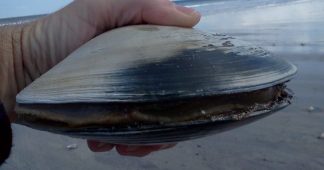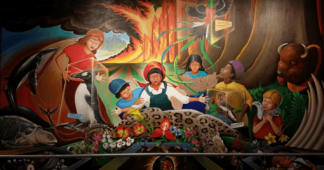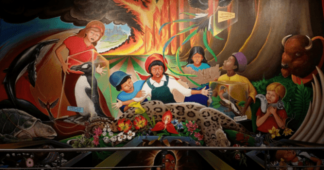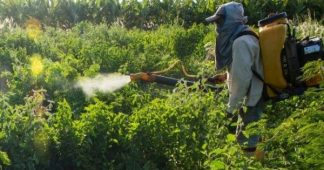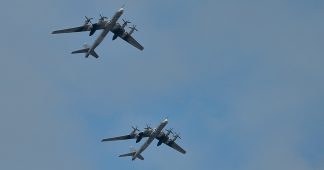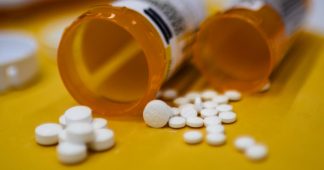By Zoya Teirstein, Grist
28 February 20
Phyllis Clough was driving to the post office in the tiny Alaskan village of Old Harbor one summer afternoon when her lips went numb. Within minutes, her mouth was swollen and the numbness had spread to the rest of her face.
She learned how close she had come to catastrophe at the local clinic the next day. She had eaten a single clam containing a naturally occurring poison a thousand times more toxic than sarin gas. The clam had been harvested by her parents, both subsistence fishers, from a beach in Old Harbor, home to 300 people on the southwestern Alaskan island called Kodiak. “You could die from one clam,” Clough recalls her doctor telling her.
Clough’s family is Alaskan Alutiiq, a tribe that has long depended on the state’s wealth of cockles, clams, limpets, urchins, mussels, geoducks, and periwinkles. “When the tide is out, the dinner table is set,” Alutiiq elders say. But increasingly, those shellfish harbor the toxin that causes paralytic shellfish poisoning, the illness that made Clough sick. Her reaction subsided within a couple of days, but the traditional foods from the ocean that have fed her tribe for thousands of years no longer pass her lips. “I’ll never eat a clam again because I’m scared of what it did to me that time,” she said. “I just never want to go through that again.”
She is 57 years old. She hasn’t touched shellfish since she was in her mid-20s.
Her mother, an 80-year-old Alutiiq elder named Mary Haakanson, has no such qualms. She still regularly eats food harvested from the sea. Clough doesn’t understand it. “We’ve actually had people die of this here,” she said. “I feel very strongly against it, but people grew up here so they want to continue eating it. It’s a traditional food, so they don’t care.”
The toxin in the clam Clough ate is colorless, odorless, and tasteless. It is also unpredictable, potentially loading up one clam with a lethal dose and skipping the one just down the beach.
For that reason, coastal states in the lower 48 have developed statewide systems to keep their recreational and subsistence harvesters safe from paralytic shellfish poisoning, or PSP. Shellfish from their beaches are regularly tested for toxins and, when necessary, authorities close the beaches to fishing. Alaska, which has more coastline than the rest of the U.S. combined, has no such system. State environmental health officials say the sheer length of its coast makes monitoring shellfish for the toxin that causes PSP impossible. Thus, it’s the only place in the nation where people still die from eating wild shellfish.
It’s also a state where close to 100 percent of the rural population depends on foraging and hunting, pulling in an average of 375 pounds of wild food a year per person. Nearly half of those rural harvesters are Alaska Native — a population that surveys show is more likely to lack access to nutritious food than the state’s non-Native residents. In the winter, when birds, seals, and fish are scarce, indigenous Alaskans — a quarter of whom live below the poverty line — turn to the ocean, where fat butter clams and mussels are ripe for the plucking year-round.
“Every kid in the village will know where to go get clams and when and where to harvest them,” said Clough’s brother, Sven Haakanson, an anthropologist and former executive director of the Alutiiq Museum in Kodiak. “If you can’t gather shellfish then you’re going to starve.” Besides, for Alaska Natives, cockles and clams are more than a dietary supplement. Tens of thousands of indigenous Alaskans regard subsistence living as a form of identity and culture.
In a typical Alaska Native community, 30 percent of the households harvest 70 percent or more of that enclave’s wild food. The bounty is shared among family members and given to single mothers, the elderly, and the disabled. It’s impossible to separate the communal aspect of subsistence living from the sustenance it provides. “It’s the Native way to share,” Delores Stokes, a Qagan Tayagungin Alaskan who grew up in Sand Point, a town on an island southwest of Kodiak, said. “If I got some clams I would offer, ‘Would you like some or do you want to come over?’”
She, too, has reason to be wary of shellfish. When she was a little kid fishing with her parents in Sand Point one summer, a man in a boat next to theirs ate some butter clams and died before he could even get to the beach. Years later, as a teenager, Stokes saw toxic shellfish poisoning up close again, when a man was medevaced to a clinic she was working in with a severe case of PSP. “His tongue was starting to swell up and he had red blotches on his face,” she said. “His fear, you could feel it.”
The last time she ate shellfish was in late April, when her neighbor harvested a batch of butter clams and called her with the good news. “I’ll be right there,” she said, and headed to the harbor. She ate the clams roasted on the half shell. “It was wonderful,” she recalled, relishing the memory. Stokes follows a simple tradition like many others — including Mary Haakanson: only harvest shellfish in months with an “R” in the name: September, October, November, December, January, February, March, and April. Following this rule didn’t eliminate the risk of PSP, but it reduced it.
At least, that was true in the past. Now, times are changing.
This summer, independent shellfish testing sites all over the state reported spikes in toxin levels, possibly related to the historic high temperatures in the water surrounding Alaska. And those warming waters are creating the ideal conditions for the algae that produce the toxin to propagate year-round, some researchers say.
Already, the incidence of PSP is creeping up in cooler months: September, October, March, and April. When Bruce Wright, senior scientist with the Aleutian Pribilof Islands Association, visits Native communities in Southeast Alaska, elders tell him that they’ve seen more PSP incidents, more months of the year when the PSP toxin is active, and higher toxicity levels than in the past. The “R” rule could soon become unreliable, if it hasn’t already.
The data coming out of the few areas of the state with regular testing hint that PSP’s toxin could one day become omnipresent in Alaskan waters, intensifying in places where it’s already found, and also creeping toward the North Pole, where it could spread into the North Atlantic and North Pacific oceans. The consequences for harvesters who are unfamiliar with PSP or have long believed that its toxin disappears when the seasons change has the potential to be catastrophic.
A small cadre of environmental researchers, tribal community members, and concerned citizens are trying to keep tabs on the chemical agent in shellfish in Southeast Alaska in order to protect subsistence fishers from this hidden threat. But challenges abound, ranging from lack of government funding to a simple lack of manpower to the fact that many Alaska Natives will likely never stop eating shellfish, no matter the risks.
Shellfish, said Coral Chernoff, a Cheyenne artist living in Kodiak, are part of the fabric of Native life, so ubiquitous they’re nearly unnoticeable — until they’re gone. Her ancestors used shells for beads and earrings, a tradition she continues in her studio. She and her family used to harvest butter clams and eat them roasted or steamed on the beach. Her Alutiiq father could eat dozens of clams, she said, as many as she could cook. But she harvests alone now. The rest of her family, scared off by the threat of PSP, may never hunt shellfish again.
A journal kept by the Russian navy officer Gavriil Davydov documents one of the first written accounts of PSP. A hunting party returning to Kodiak from Sitka, in southeastern Alaska, in 1799 stopped to spend the night in a cove where clams and mussels grew in abundance. Minutes after finishing their dinner, six Native Americans died. “All those who had eaten the shellfish grew very frightened — but no one knew what to do to help,” Davydov wrote. “Some ate sulphur, others rotting iukola [strips of dried or smoked fish], others tobacco or powders to induce vomiting.” Over the course of the next few hours, nearly 100 men died — an invisible massacre. The officer’s account noted that “the same shellfish can be harmful at one time of the year and at other times harmless.”
The unpredictable nature of PSP is one of the most terrifying things about it. Mary Haakanson ate dozens of clams from the same catch that made her daughter, Phyllis Clough, sick all those years ago, and walked away without any reaction.
The truth is that without lab equipment, it’s impossible to know when shellfish “go hot.” Saxitoxin, the poison that causes PSP, has no detectable effect on shellfish flesh. You can’t neutralize it by frying, boiling, or freezing like you would with bacteria. Alaskan subsistence fishers call harvesting your own shellfish “Alaskan roulette” — a nod to the fact that shellfish toxicity can vary beach to beach, harvest to harvest, clam to clam.
The poison itself is produced by a tenacious type of algae called alexandrium catenella, which hibernates in hard cysts on the ocean floor when water temperatures drop, biding its time until the sun comes back. When it reemerges, shellfish, one of the ocean’s most efficient filtration systems, rapidly accumulate the algae and the toxin it produces.
Once saxitoxin enters the human bloodstream, it prevents neurons from firing normally. Signs of PSP tend to develop within a half hour: First, a tingling or burning sensation in the fingertips and lips. Then nausea, vomiting, diarrhea, and finally full paralysis of the respiratory system and death. Just one milligram can be fatal, and there is no antidote.
People who have experienced a run-in with PSP and lived to tell the tale aren’t quick to forget it. Dan Clarion, another Old Harbor resident, remembers eating dozens of butter clams one summer when he was a young commercial fisherman with a couple of days to kill in between jobs. Within minutes, he was laid flat on his back, struggling to fill his half-paralyzed lungs with air. Like the majority of people who have survived PSP, he emerged from the incident with a terrifying anecdote and a healthy dose of fear. Now he helps researchers test shellfish for toxins in his village.
According to data collected by the state, four people have died from PSP since 1993, and 120 have fallen ill total. But that number is almost certainly an underestimate, considering tests of butter clams and blue mussels throughout Alaska in the past 30 years have consistently turned up some of the highest levels of saxitoxin in the world.
The size of the state and the far-flung nature of its communities makes keeping track of PSP incidents nearly as difficult as establishing a shellfish-monitoring network. Part of the problem is that folks who have experienced a run-in with the toxin are charged with self-reporting it to the Alaska Department of Health and Social Services, the agency that logs illnesses and, depending on the circumstance, issues public service announcements warning Alaskans of heightened danger. But residents might not know who to call to report the incident, or even know that they’re supposed to report it in the first place, said Louisa Castrodale, an epidemiologist with the department. Those who have experienced a mild case might take it for food poisoning or the flu. Doctors might even confuse symptoms of severe shellfish poisoning with a heart attack. The official records of a problem the department has classified as a public health emergency could be just a tiny fraction of what’s actually playing out on the ground.
According to the statistics on hand, toxic shellfish poisoning hits Kodiak particularly hard. Roughly a third of all reported PSP incidents in Alaska between 1993 and 2014 came from Kodiak and the smaller islands that surround it. Scientists don’t know why area shellfish frequently turn up such high levels of saxitoxin, but data collected by researchers in the Gulf of Alaska over the past several decades show levels many thousands of times greater than the federal limit of 80 micrograms per 100 grams of shellfish flesh (that’s a little less than one part per million). In the late 1980s — around the time Clough got sick — saxitoxin levels in Kodiak topped 20,000 micrograms. For context, butter clams with just 1,000 micrograms of the chemical have caused near-instant death.
Tribes have been aware of PSP since long before researchers first extracted its toxin from the flesh of an Alaskan butter clam in 1957. A series of tips and tricks ranging from dubious to mildly effective were all that stood between Alaska Native populations and PSP. Alexandrium thrives in warm water and sunlight, which is a big reason why the “R” rule has served many communities relatively well in the past. Some harvesters also scrape out the gut of the clam and snip off its siphon — the two areas that testing has shown hold the highest concentrations of saxitoxin.
Neither method is reliable. While amounts of the chemical found in shellfish typically dip below 80 micrograms in cold months, dangerous levels have turned up even in the dead of Alaskan winter. A researcher who tested indigenous cleaning methods found that while gutting and snipping the catch did make some types of shellfish less toxic, it did not eliminate the toxin entirely. PSP also affects people differently depending on their body weight, what they ate that day, and how much shellfish they consumed.
Other methods some Natives swear by include first feeding a bit of your catch to the neighborhood cat to see what happens, boiling clams with a silver dollar, or avoiding red tides — which are related to algae but not necessarily to alexandrium. These shaky methods have been used for so long they’re thought of as fail-safes. Every few years, another death proves that they are not. But without a consistent, reliable network to detect outbreaks and warn the population, people along the Alaska coast have few options.
At 6 a.m., the tide was nearly out at Mission Beach, a rocky length of shoreline minutes from Kodiak’s main road. As the sun began to lighten the sky, pinks — a type of salmon that takes Alaskan waterways by storm in autumn — glinted in the waves, and an eagle made slow circles overhead. Across the water, a cluster of dark islands formed a loose line between Kodiak and the Gulf of Alaska. Many of those islands and the islands beyond them are majority Native and only accessible by seaplane, helicopter, or boat.
Andie Wall, an environmental technician, pulled into the parking lot and jumped out of her car. She popped the trunk and began pulling on a pair of waders for her morning’s work. The organization she works for, a health and social services nonprofit called the Kodiak Area Native Association, or KANA, started an initiative in 2019 to test blue mussels, butter clams, and seawater at three traditional harvesting sites in Kodiak for saxitoxin and two other shellfish-borne poisons.
“Part of the reason I took this job is because my family used to eat clams all the time, especially in the summer,” Wall said. After someone got PSP in her town, located on the opposite end of Kodiak Island, word of the danger started to spread through her community. KANA serves indigenous communities in Koniag — one of Alaska’s 13 Native regions — even the villages you can only get to by boat.
Wall and a couple of volunteers spread out over the beach, tailed by Wall’s energetic white labrador, Izzy. First, they plucked 70 blue mussels from the beds exposed by the receding tide. Using shovels and rakes, they dug holes three feet deep in the sand, looking for elusive butter clams. Every once in a while a little spout of water shot up out of the hole in the sand inches from where the volunteers were scraping around in the muck — proof the clams were down there. Half an hour later, the volunteers had about a dozen clams, which is enough to send off for testing.
During the previous several months, Wall had recorded three potent marine toxins at each location where she had conducted tests. One of them, of course, causes PSP; the other two respectively cause diuretic shellfish poisoning, which can induce prolonged bouts of diarrhea, and amnesic shellfish poisoning, which can cause short- and long-term memory loss. That data goes on the KANA website and various community Facebook pages. When toxins spike into the thousands of micrograms, Wall and other researchers in Kodiak will reach out to local media outlets, who can disseminate the information to a wider audience. “We’re not going to go red alert every time it’s above the regulatory limit because chances are, in Kodiak, it’s above the regulatory limit,” she said.
Back at the lab, Wall stood over the sink and cracked open the butter clams and mussels dug up at Mission Beach and Trident Basin, another testing site a few miles away. She packaged up the soft flesh and sent it by plane to Sitka, where the state’s only lab dedicated to testing non-commercially harvested shellfish is located. It’s run by Chris Whitehead, a shellfish biologist who spent years working on a statewide warning system for toxic shellfish poisoning in Washington state.
Now in its third year of operation, Whitehead’s lab works with 16 tribes in the southeastern portion of Alaska — the region that consistently experiences the highest levels of PSP toxin — analyzing shellfish from beaches that those tribes frequently fish. The initiative, called Southeast Alaska Tribal Ocean Research (SEATOR), has blossomed into Alaska’s first coordinated effort to date to help launch and streamline testing efforts. The program keeps track of shellfish data from 42 beaches across Southeast Alaska, including the ones in Kodiak. As of February, however, many of those sites had no recent data to report.
Whitehead’s lab is also a resource for any Alaskan in the state who wants their shellfish tested. Individual fishers and public health workers like Wall can send their shellfish to Whitehead for $50 per sample. Through Walls’ program, subsistence fishers from Kodiak who can’t afford the $50 fee can send their samples to the Sitka lab for free, though funding for that particular aspect of Wall’s project is running out. For harvesters who are willing to wait a few days to get their test results back, the system has been an effective, if inconvenient and expensive, solution. “Since my team was up and running in 2015, nobody at any of our sites has gotten sick,” Whitehead said.
Wall sent her samples off to Sitka, but because the lab was running low on a key component of its tests, she didn’t get her results back until nearly a month later. The report showed wildly different results for the shellfish harvested that day at Mission Beach. Blue mussels at the west end of the beach turned up 153 micrograms of saxitoxin per 100 grams — above the regulatory limit, but not extreme. On the east end, fewer than 50 yards away, mussels came back with 756 micrograms of toxin, almost 10 times the regulatory limit. “Same beach, same day, large variation between locations,” Wall said. If she’d known about those results in time, she would have alerted the media — but by the time she received the report, it was too late. Shellfish can amass and filter out saxitoxin so quickly that data becomes unreliable after about a week. “There was nothing anyone could do,” she said.
Wall’s efforts — and SEATOR’s program in general — still only cover a fraction of the active fishing grounds in Alaska; most beaches have no saxitoxin surveillance at all. But state officials point out that setting up a statewide monitoring network that could do what Wall does would be a huge undertaking for a massive and sparsely populated state. “It’s almost impossible for us to wrap our arms around a coastline that’s this large,” said Kimberly Stryker, program manager for the state’s Food Safety and Sanitation Program, which is housed within the Department of Environmental Conservation. The state doesn’t require permits to harvest shellfish in most cases, she explained, which is another reason why it lacks the resources to establish a monitoring network.
One way to better manage such an unpredictable and potentially deadly foe would be with a rapid field test, so fishers could get information about their specific catch right away, before dinnertime. Since 2016, Julie Matweyou, a marine advisory agent with the university research program Sea Grant, has been working to develop a tool that could tell people exactly how toxic their shellfish is right there on the beach, down to the precise microgram. She was planning to get a field test into people’s hands last summer, but the company Matweyou was working with ran into problems getting the kit’s biochemistry to function reliably. “We’re not there yet,” she told Grist.
But Matweyou is still working to protect Alaskan communities from PSP. By conducting tests at beaches that serve as traditional harvesting sites, developing relationships with community residents, and sharing limited grant money, she has shared resources and know-how with Wall, as well as with the Sun’aq tribe and various Native and non-Native volunteers to patch together their own ad hoc shellfish monitoring system covering a few clamming spots on Kodiak. The alliance is teaching the community how to “harvest and hold” — collect clams and mussels, send a sample to Chris Whitehead’s lab to get tested, and wait until the results come back before digging in. It’s round-the-clock work, but the team knows a lapse in its efforts could have lethal consequences. They’re striving to protect a way of life that is fundamentally Alaskan and intrinsically Native.
Even just a few weeks of missing data could undermine long-term efforts to identify trends in shellfish toxicity in the area, they say, because it takes decades of consistent testing to establish those patterns. But more importantly, they know that subsistence fishers are going to harvest no matter what. Arming the populace with the facts — by visiting local radio stations for interviews or getting the word out in villages, if shellfish test really hot — will at the very least help people make informed decisions about which beaches to visit and when.
This homemade safety net shows promise. Awareness of the dangers posed by shellfish is high in Kodiak. In turn, the researchers have been careful not to raise the alarm about high toxicity levels unless absolutely necessary, in order to maintain trust with people who can’t afford to stop harvesting.
It’s a delicate balance, one that’s complicated by the fact that rising temperatures have made other sources of food harder to find. Record-breaking heat this summer in most parts of Alaska wilted wild plants and herbs. Blueberries ripened a month early, catching harvesters off guard, and blight blackened swaths of salmonberry bushes. Drought hit the state as pinks were headed upriver to spawn, stranding them at the mouths of streams where they died in mottled piles, roe decaying in their bellies. Birds and seals died in unprecedented numbers in the Bering Sea, starved to death due to a lack of krill and copepods, and, some researchers speculate, from ingesting the PSP toxin. Meanwhile, under the sand, snugly ensconced in their pure white shells, butter clams remained as plump and abundant as ever.
Sven and Mary Haakanson parked in front of Harborside Coffee, a cafe across from the fishing docks in Kodiak, the city, where commercial fishermen, tourists, and service members from the nearby Coast Guard base mingle in the mornings. Sven helped his mother, a wizened woman no taller than 5 feet, out of the car and into the shop. When they sat down, Sven started asking the questions, carefully pulling at threads he knew would help Mary recall memories from decades past. So much of the Alutiiq way is kept alive in the memories of elders. When they’re gone, he said, so are the stories.
There are ways to keep traditions alive. Several years ago, the Haakansons traveled to Sitka to attend the memorial of the mass shellfish poisoning documented in the journal of Gavriil Davydov, the Russian naval officer. The Alutiiq remember this incident well, in part because the Tlingit — a tribe native to Sitka — made sure they never forgot it. “They kept songs alive from our region for over a century,” he said. “When we went down for that celebration, they gifted the songs back.”
Speaking softly in her ear so she could hear him over the hum of the cafe, Sven asked Mary, one of approximately 200 native Alutiiq speakers left in the world, to say the Alutiiq word for clam. “Mamaayaq,” she said in a hoarse voice no louder than a whisper. What about mussels, he asked. Mary shrugged. She has forgotten. But she still remembers something her mother used to tell her about harvesting clams. “Mom used to say when the water gets warm be careful,” she said. “They knew. I don’t know how, but they knew.”
The clink of cups and hiss of steamers nearly drowned out the sound of Mary whispering her own warning: “They say someday it’ll get warm,” she said, looking out at the harbor. “But it’s here today.”
